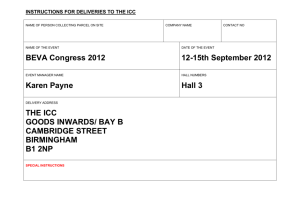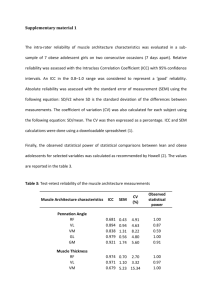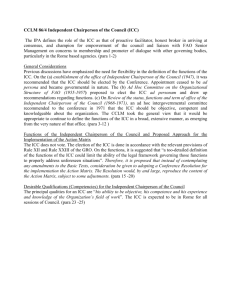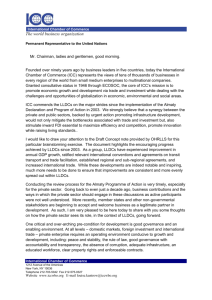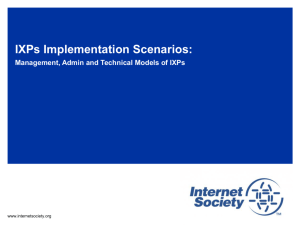Internet Backbone Interconnection Agreements
advertisement
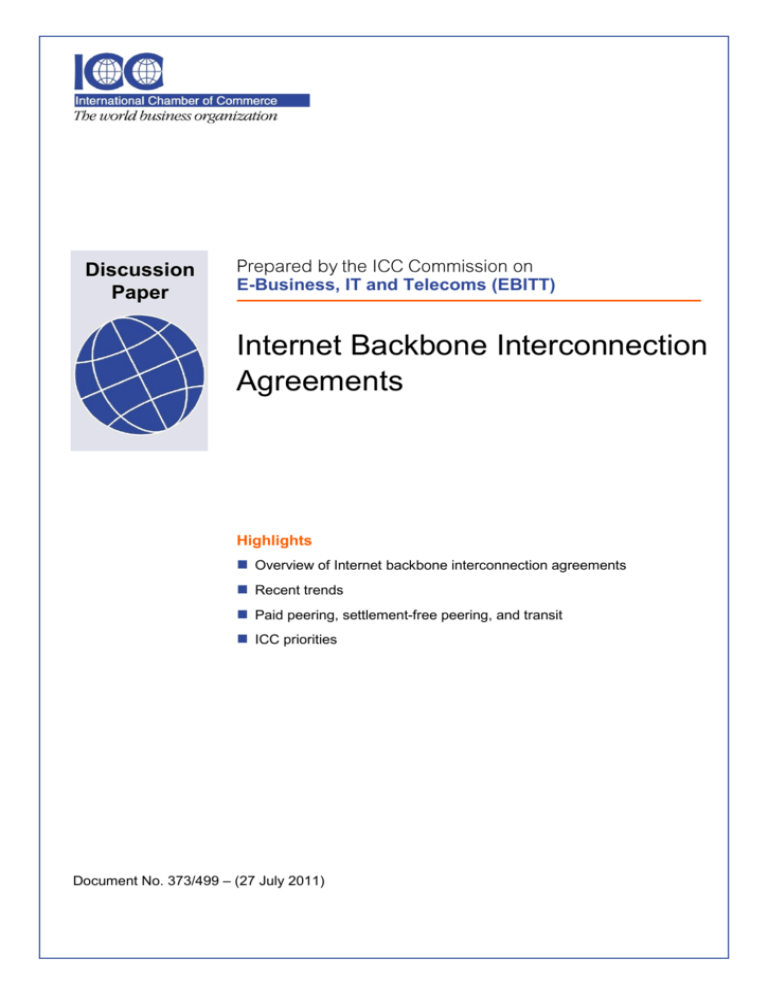
Discussion Paper E-Business, IT and Telecoms (EBITT) Internet Backbone Interconnection Agreements Highlights Overview of Internet backbone interconnection agreements Recent trends Paid peering, settlement-free peering, and transit ICC priorities Document No. 373/499 – (27 July 2011) ICC Discussion Paper on Internet Backbone Interconnection Agreements Internet Backbone Interconnection Agreements Discussion paper In the more than fifteen years since the commercialization of the Internet backbone, unprecedented innovation and investment has resulted in a huge increase in global Internet availability and usage. During this period, a wide variety of commercially negotiated Internet backbone interconnection arrangements connecting national and international Internet backbone providers, content providers and Internet Service Providers (ISPs) have fuelled and sustained the massive growth of the Internet into a global network of interconnected networks. These Internet backbone interconnection arrangements have evolved dynamically in response to increases in global demand and the shift towards content requiring higher bandwidth, without being subject to burdensome economic or social regulation. Despite the huge success of this commercial model, there have been various proposals to regulate the terms of international Internet backbone interconnection agreements, based on claims that regulation may promote further investment. ICC’s Task Force on Internet and Telecoms Infrastructure and Services (ITIS) and ICC’s Commission on E-Business, IT and Telecoms (EBITT) have a strong interest in the growth and stability of the international Internet infrastructure, and has long been convinced that this interest is best served when Internet backbone interconnection agreements are not regulated. Proposals to regulate these agreements may be based on a partial understanding of the facts and policy options. To contribute to the policy-making discussions that continue on this subject, and to foster the on-going investments required to further expand the Internet, the ITIS Task Force seeks to promote a better understanding of Internet backbone interconnection agreements, and of the related policies that promote growth of robust Internet infrastructure and services in different regions. To serve this goal, ICC commends a February 2011 study conducted by Analysys Mason, titled “Overview of Recent Changes in the IP Interconnection Ecosystem.” The study provides details on the most compelling trends in the international Internet Interconnection market. It describes in detail the distinctions among the different forms of commercial interconnection arrangements -- such as paid 1 peering, settlement-free peering, and transit -- and how these agreements have accommodated mushrooming global Internet usage as well as corresponding increases in traffic from newly available multimedia content. The background description of how each form of agreement works is a useful primer for public policy professionals interested in this topic. The Analysys Mason study demonstrates that over the past 15 years, in the absence of any regulation of Internet interconnection agreements, competitive market mechanisms have brought substantial changes in inter-regional and intra-regional Internet traffic flows, resulting in more efficient network usage, improved network performance and investment growth. The report shows in detail how this favourable regulatory environment has fostered investment in regional infrastructure and Internet Exchange Points (IXPs), and has already resulted in three distinct phases in the brief history of 2 commercial Internet connectivity: 1 The report includes an extended explanation of these forms of agreement. A transit agreement is for a fee, and may only require a connection at one place and gives access to the entire Internet. Typically, settlement-free peering gives access only to the peer’s customers. Internet backbone providers must connect to multiple other backbones and/or purchase transit from another provider in order to achieve a global reach. Another difference from transit is that traffic delivered under settlement-free peering is subject only to “best effort” delivery, and there is generally no formal Service Level Agreement between the parties. In a commercial environment, service providers use a mix of transit and peering to achieve their price and quality needs. 2 The Analysys Mason study focuses on the positive steps of regulatory enablement that have fostered investment in regional infrastructure and IXPs. For an interesting additional perspective, to see how an inadequate commitment to market liberalization and competition has been shown to stifle investment in Internet infrastructure and services, see Williams, Broadband for Africa, Policy for Promoting the Development of Backbone Networks, World Bank InfoDev 2008. Additionally, the World Bank has prepared a comprehensive study on steps that developing Document number 373/499 – page 2 ICC Discussion Paper on Internet Backbone Interconnection Agreements Paid peering, settlement-free peering, and transit (1) US-centric, in which the routing of international Internet traffic was concentrated in the United States -- and much of that was traffic that originated in one country to be routed through the US and sent back to the same country for termination (a practice also known as tromboning). (2) OECD-Centric, in which IXPs were established in parts of Europe and Asia (mostly in OECD economies) to localize traffic and thereby lower the cost of Internet interconnection while also reducing latency; and (3) Rest of World-centric, a current phase in which IXPs are increasingly established in the emerging markets, fostering the global development of local traffic and local content, and thereby further reducing inefficient international Internet traffic flows. Although IXPs in emerging markets have existed for several years, the impact of both the IXPs and also of market liberalization on traffic flows, have increased recently. This increased globalization of IXP locations is demonstrated in the following chart. Figure 1: Number of IXPs by region [Source: Packet Clearing House (www.pch.net), Analysys Mason estimates] The impact of these trends on global Internet traffic, and in turn on the evolving terms of Internet 3 interconnection agreements, has been significant. Internet bandwidth connections from each region of the world to North America have declined significantly during the past decade, showing a major shift away from the former US-centric pattern of international connectivity. In particular, local Internet Exchange Points in multiple countries have now supplanted much of the prior need for international connectivity, as in the case of Asia and Europe. The increase in deployment of regional fiber networks, and subsequent regional connectivity (by means of both regional peering and regional transit), have also contributed to the decrease in non-optimal routing across expensive trans-Atlantic and transPacific connections. Further, Europe has supplanted the US as the preferred transit point in the case of Africa traffic. Unfortunately much of the regional African traffic still must transit Europe instead of being routed locally and regionally. Latin America is the region that relies most heavily on US connectivity today, compared with other regions, but has also reduced this reliance from 95% in 2003 countries can take to promote broadband and Internet infrastructure. See, Kim, Kelley and Raja, Building Broadband: Strategies and Policies for the Developing World, World Bank InfoDev 2010. 3 For a recent study of Internet interconnection agreements, see Packet Clearing House’s “Survey of Characteristics of Internet Carrier Interconnection Agreements,” Bill Woodcock & Vijay Adhikari, May 2011. https://pch.net/resources/papers/peering-survey/PCH-Peering-Survey-2011.pdf Document number 373/499 – page 3 ICC Discussion Paper on Internet Backbone Interconnection Agreements (see figure below). For both the Africa and Latin America regions, the amount of non-optimal transit traffic through other regions should decrease as enabling regulatory environments promote the expansion of more local/regional IXPs, regional fiber networks, and regional connectivity. Figure 2: International Internet Connectivity Trends [Source: TeleGeography, Analysys Mason] The IXPs and the rich regional fiber connectivity that have driven the shifts in traffic away from the US towards other regions bring important benefits to their home countries. In particular, there appear to be three situations for any country as regards the impact of an IXP: No IXP – No IXP is operated in the country, and local ISPs have international connectivity 4 typically via the incumbent operator who has a significant share of Internet interconnection. Part of the domestic traffic is typically subject to international tromboning, and most content and 5 services is accessed from IXPs, data centers and server farms in other countries. IXP ‘spoke’ – A small IXP is operated in the country, and several national Internet backbone providers and ISPs use the facility for peering, in order to avoid tromboning. Content and services are still largely located abroad but some services (e.g., DNS root server or ccTLD server) can be collocated with the IXP. Transit providers can collocate at the IXP to offer transit through private 6 connections. IXP ‘hub’ – A large IXP is operated in the country, to which most of the national Internet backbone providers and ISPs are connected, as well as major global Internet backbone providers and 7 regional Internet providers. A significant part of the local and regional traffic goes through the local IXP. In addition, major global providers can collocate at the IXP and offer transit through private connections. Note: Use of the terms “spoke” and “hub” should not be taken to mean that a “spoke” IXP is directly connected to a “hub” IXP. Generally, IXPs in different countries or regions are not directly connected 4 See supra Broadband for Africa at p. 23-25 (highlighting how in many countries, ISPs are legally required to purchase International Internet connectivity from the incumbent provider, and discussing how this regulatory requirement limits further competition and investment in fiber networks, and in ISP supply choice.) 5 Examples of such content and services include: DNS, email (e.g., gmail, Hotmail), web hosting, Facebook, Google or Bing search. In some rare cases, a country’s ccTLD might be hosted abroad. 6 In general, transit is not provided over the IXP switch fabric; however, transit providers can collocate at the same location as the IXP and offer transit services via private connections, which in turn connect to other IXPs or to other ISPs. 7 Development of such an IXP requires that the host country allow ISPs from neighbouring countries to easily acquire capacity and peer with local and national ISPs at the IXP. Therefore, regional cooperation is essential, as expressed through regulations that foster cross-border information flows. Document number 373/499 – page 4 ICC Discussion Paper on Internet Backbone Interconnection Agreements to each other. Connectivity between IXPs in different cities or countries is provided by the regional or global ISPs themselves, and not by the IXP. IXPs tend to be developed in metropolitan areas that minimize the cost for ISPs to connect. A bottomup, ISP community-driven approach that supports flexibility in terms of voluntary interconnection agreements has shown to be more successful in developing countries, than top-down mandates. The decision to connect at an IXP and the decision of who to peer with at the IXP are at heart privatesector business decisions based on network traffic analysis and business relationships. IXPs themselves are a tool for interconnection, not an independent business case. The Analysys Mason report also describes the factors that have proven most successful in increasing investment in local Internet infrastructure, and in raising the volumes of local traffic: namely, ensuring a liberalized market that is open to investment; adopting pro-competitive policies for access to basic infrastructure; and supporting community development of IXPs that efficiently exchange local traffic. The report describes a market-driven roadmap for increasing Internet infrastructure investment in developing markets. It demonstrates that when there have been prior market inefficiencies, e.g., during the rapid transition from a US-centric Internet to a global Internet, market mechanisms, rather than regulation, have driven the improvement of Internet infrastructure and performance. The evolution of market mechanisms is also illustrated by the rise of content distribution networks that 8 cache popular content locally for retrieval instead of transiting expensive connections. Looking forward, the report also supports the conclusion that allowing these market mechanisms to further localize traffic will best promote the network investments necessary to accommodate the significant increases in traffic resulting from multimedia content, while lowering cost and reducing latency with more optimal traffic routing. ICC priorities In particular, ICC notes that current proposals to regulate international Internet infrastructure aim to shift costs between countries, rather than shifting the underlying traffic flows that result in those costs. The latter approach of shifting the underlying traffic flows has been the successful market-driven model over the past 15 years. There remains important work ahead to further expand affordable Internet capacity in developing countries, and to encourage even more investment in both developing and developed countries. Based on the studies referenced in this ICC Paper – by Analysys Mason, the World Bank, and Packet Clearing House -- there is a basis to expect that all markets with a pro-competitive regulatory framework for infrastructure and IXP investment, and which support a commercially negotiated approach to Internet interconnection agreements, will continue to see improvements in Internet availability. The study, “Overview of Recent Changes in the IP Interconnection Ecosystem” can be found at the following web-site: http://www.analysysmason.com/AboutUs/News/Insight/Internet_exchange_points_Feb2011/Related-report-download/ ICC recommends that policy-makers first promote the successful pro-competition models highlighted in the study for achieving more efficient and balanced Internet interconnection flows before considering the imposition of regulations that could suppress traffic flows and investment incentives. The public and private sectors are aligned in recognizing the important economic and social benefits that will come with expanded Internet capacity, and this discussion paper shares a time-tested framework for advancing this goal. This material can be helpful as individual countries consider their national broadband plans, as regions consider ways to work bilaterally and plurilaterally on Internet investment policies, and as multi-stakeholder community addresses Internet governance at multilateral settings. 8 For a discussion of the effects of content distribution networks on the evolution of Internet architecture, see North American Network Operator’s Group 47, 2009 Internet Observatory Report, Oct 19, 2009, available at url: http://www.nanog.org/meetings/nanog47/abstracts.php?pt=MTQ1MyZuYW5vZzQ3&nm=nanog47 Document number 373/499 – page 5 The International Chamber of Commerce (ICC) ICC is the world business organization, a representative body that speaks with authority on behalf of enterprises from all sectors in every part of the world. The fundamental mission of ICC is to promote trade and investment across frontiers and help business corporations meet the challenges and opportunities of globalization. Its conviction that trade is a powerful force for peace and prosperity dates from the organization’s origins early in the last century. The small group of far-sighted business leaders who founded ICC called themselves “the merchants of peace”. ICC has three main activities: rules-setting, dispute resolution and policy. Because its member companies and associations are themselves engaged in international business, ICC has unrivalled authority in making rules that govern the conduct of business across borders. Although these rules are voluntary, they are observed in countless thousands of transactions every day and have become part of the fabric of international trade. ICC also provides essential services, foremost among them the ICC International Court of Arbitration, the world’s leading arbitral institution. Another service is the World Chambers Federation, ICC’s worldwide network of chambers of commerce, fostering interaction and exchange of chamber best practice. Business leaders and experts drawn from the ICC membership establish the business stance on broad issues of trade and investment policy as well as on vital technical and sectoral subjects. These include financial services, information technologies, telecommunications, marketing ethics, the environment, transportation, competition law and intellectual property, among others. ICC enjoys a close working relationship with the United Nations and other intergovernmental organizations, including the World Trade Organization, the G20 and the G8. ICC was founded in 1919. Today it groups hundreds of thousands of member companies and associations from over 120 countries. National committees work with their members to address the concerns of business in their countries and convey to their governments the business views formulated by ICC. ICC Commission on E-Business, IT and Telecoms (EBITT) Business leaders and experts drawn from the ICC membership establish the key business positions, policies and practices on e-business, information technologies and telecommunications through the EBITT Commission. With members who are users and providers of information technology and electronic services from both developed and developing countries, ICC provides the ideal platform to develop global voluntary rules and best practices for these areas. Dedicated to the expansion of cross-border trade, ICC champions liberalization of telecoms and development of infrastructures that support global online trade. ICC has also led and coordinated the input of business around the world to the World Summit on the Information Society, Geneva 2003, Tunis 2005, and continues this effort in the activities established in the Tunis Agenda through its initiative, Business Action to Support the Information Society (BASIS http://www.iccwbo.org/basis).

